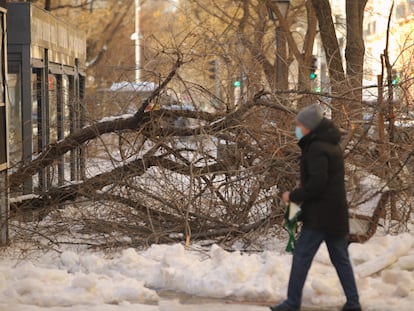Why claims that a new Filomena snowstorm is headed for Spain are nothing more than an old wives’ tale
Meteorologists are wearily warning against trusting ‘las cabañuelas,’ a traditional system for forecasting the weather that has gained new popularity thanks to a 15-year-old who claims a repeat of the 2021 event is due on January 24

Is it true there will be another Filomena snowstorm in Spain this January? The question has been doing the rounds ever since 15-year-old Jorge Rey predicted last fall that we could well be looking at an event similar to the historic weather episode at the start of 2021. His prediction is, however, based on nothing more than an old-fashioned method known as “las cabañuelas” that was used by shepherds and farmers in Spain and Latin America to predict the weather, before the existence of meteorology.
“This method was still being used in the 1980s, but I didn’t think anyone would believe in such a thing nowadays,” says Ángel Rivera, former spokesman for Spain’s Aemet meteorology agency, sounding weary.
Aside from a desperate bid for clicks on the internet and social media repercussion, the resurgence of the cabañuelas readings can be attributed to Rey, who hails from Monasterio de Rodilla in the northern province of Burgos. Having learned to read the cabañuelas from a local shepherd, he is being described by some as a child meteorologist and attracting massive media coverage. A self-styled “naturalist and weatherman,” Rey has predicted we will have a hard winter, rainy spring and an unstable summer. He has also not ruled out another episode like Filomena.
It is a non-scientific method of pseudo-forecasting; the horoscope of meteorologyBeatriz Hervella, spokesperson for Aemet
However, many meteorologists have chosen to ignore Rey’s predictions in order to play down their importance. Without mentioning his reading of the cabañuelas, Aemet published a video in November in which the probability of a repeat of last year’s historic snowstorm was said to be a mere 1%. But on January 9, a journalist let slip on the state broadcaster’s TVE 1 station that the city of Madrid was beefing up its resources by 35% to cope with a potential new Filomena as predicted by the cabañuelas. City officials had “nothing to say” on the matter and merely pointed to a press release from last week that mentioned neither the cabañuelas nor a new Filomena. The increase in resources to cope with a cold snap is real, but it is due to new street-cleaning specifications, drawn up according to the needs of the city rather than any forecasted snowfall. The reporter, Rosa Correa, apologized for her “mistake” on Twitter, but the seriousness with which it was taken by the public has concerned meteorologists.
Ante las críticas recibidas por como acabo este directo hablando de Las Cabañuelas. Mi respeto siempre a la ciencia y a mis compañeros del @ElTiempo_tve. Y mis más sinceras disculpas si les ha molestado que hablara de ello. A ellos y a los que se dedican a la meteorología.
— Rosa Correa (@rosacorrea_tv) January 9, 2022
“It is a non-scientific method of pseudo-forecasting; the horoscope of meteorology,” says Beatriz Hervella, spokesperson for Aemet. Reading the cabañuelas consists of observing weather parameters, such as temperature, cloud shape and wind direction, and also animal behavior, such as the flight of birds and the presence of winged ants, during the first 12 days of August – or January in Latin America – with each of the 12 days corresponding to a month of the year. For the next 12 days of August, each day corresponds to the months going backwards. There are further calculations for August 25 through 30, and special ones for August 31.
The term comes from the Jewish feast of Tabernacles and is mentioned in documents from the 11th century. “It is a folkloric tradition that has no validity,” explains Hervella, who adds that it involves neither a scientific method nor assessment. Aemet has, for example, an 84.3% degree of accuracy on the day ahead regarding maximum temperatures, with a margin of error of less than two degrees.
“It makes no sense to infer that because the atmosphere behaved in a certain way in August, it will snow in January, because the atmosphere has no memory,” explains Hervella. “Its own chaotic and complex nature, which we analyze with nonlinear equations, theoretical models, a large amount of data and supercomputers, prevents us from providing a reliable and highly probable forecast of a specific event such as snowfall beyond seven or 10 days ahead.” Forecasting a Filomena event for a specific day weeks or months in advance is “simply and utterly impossible,” she adds, while Francisco Martín, coordinator of the magazine RAM Meteorology, does not understand how there are “media outlets that lend themselves to this circus.”
Daniel Santos Muñoz, an expert in supercomputing applied to meteorology and a systems project manager in the European meteorological consortia Accord and Hirlam, points to the major advances of meteorology over the last 30 years, but warns that “the greater the scope, the lower the reliability. We have improved a lot in short-term forecasting,” he says. “We have advanced one day per decade and today we have the same probability of being right about the weather five days from now than we were 20 years ago about what the weather would be like two days later.”
Santos Muñoz goes on to highlight “the zero reliability” of these ancient beliefs, which he compares to Pennsylvania’s mythical groundhog weather forecaster Punxsutawney Phil, Paul the Octopus, who predicted Spain’s victory in the 2010 World Cup, homeopathy or tarot cards. “A doctor takes an X-ray, he examines you, applies his knowledge and gives you a diagnosis and a pill,” he says in a bid to illustrate his point. “This is like going to the quack doctor who looks at your left toenail and tells you that you have gastroenteritis.”

Juan Jesús González Alemán, a researcher in atmospheric dynamics, is astonished to see how something like the cabañuelas could gather such momentum with no one putting a stop to it. Believing the method is “to meteorology what astrology is to astrophysics,” González states that taking it seriously undermines both journalism and his own profession. In his opinion, it is “a symptom of the lack of meteorological and scientific culture.” Pointing out that in the United States and the United Kingdom a training certificate is required for weather presenters, Martín compares the cabañuelas rumors to end-of-the-world predictions and believes that it is “a sign of the times in which fear is used to trigger an irrational response in society.”
Clearly, the cabañuelas phenomenon has irked professionals in the field, who warn the public that it should not trust the “readings” or other traditional weather forecasting methods such as the Calendario Zaragozano, an annual publication dating back to 1840 whose forecasts are “neither fulfilled nor sustained,” according to Rivera.
“This nonsense is being normalized in the media,” says Hervella, who underscores that meteorology is a branch of physics and that 1,100 experts follow the evolution of the weather at Aemet. Calling for scientific rigor, Rivera stresses that last year’s Filomena storm was predicted with total accuracy four or five days before it happened, something that would have been unthinkable just 10 years ago.
However, climate change has added another layer of complexity to forecasting the weather. “One cabañuelas reader admitted to me, just as global warming was beginning to be talked about, that he could no longer forecast the weather because things had changed so much,” he says.
According to the science, it looks as though conditions just aren’t right for another Filomena. “There is a very robust anticyclone,” notes Hervella, something that largely precludes an episode of this nature. Should the cabañuelas reading be proven accurate, it would, she says, be nothing more than a case of “luck and chance.”
Tu suscripción se está usando en otro dispositivo
¿Quieres añadir otro usuario a tu suscripción?
Si continúas leyendo en este dispositivo, no se podrá leer en el otro.
FlechaTu suscripción se está usando en otro dispositivo y solo puedes acceder a EL PAÍS desde un dispositivo a la vez.
Si quieres compartir tu cuenta, cambia tu suscripción a la modalidad Premium, así podrás añadir otro usuario. Cada uno accederá con su propia cuenta de email, lo que os permitirá personalizar vuestra experiencia en EL PAÍS.
¿Tienes una suscripción de empresa? Accede aquí para contratar más cuentas.
En el caso de no saber quién está usando tu cuenta, te recomendamos cambiar tu contraseña aquí.
Si decides continuar compartiendo tu cuenta, este mensaje se mostrará en tu dispositivo y en el de la otra persona que está usando tu cuenta de forma indefinida, afectando a tu experiencia de lectura. Puedes consultar aquí los términos y condiciones de la suscripción digital.
More information
Últimas noticias
A survivor’s account of the Interoceanic Train accident: ‘We were scared because of the speed on the curve’
The Interoceanic Train, the Mexican alternative to the Panama Canal
What is known about the Interoceanic Train derailment in Oaxaca
Trump turns a Minnesota fraud allegation into ammunition for his MAGA army against Democrats
Most viewed
- Oona Chaplin: ‘I told James Cameron that I was living in a treehouse and starting a permaculture project with a friend’
- Reinhard Genzel, Nobel laureate in physics: ‘One-minute videos will never give you the truth’
- Why the price of coffee has skyrocketed: from Brazilian plantations to specialty coffee houses
- Pablo Escobar’s hippos: A serious environmental problem, 40 years on
- Chevy Chase, the beloved comedian who was a monster off camera: ‘Not everyone hated him, just the people who’ve worked with him’











































